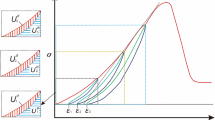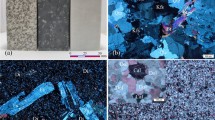Abstract
Rock brittleness is an essential mechanical property, which plays a significant role in rock classifications and rockburst risk evaluations. To overcome the problems associated with the traditional brittleness indexes not comprehensively charaterizing the rock strength and deformation behaviors, this study systematically summarized the existing rock brittleness indexes. Then, a novel brittleness index (BICSS) based on the complete stress–strain curves of rock under different confining pressures was proposed. Its advantages included innovatively considering the characteristic stresses and strains at the stage of crack initiation, the peak points, and residual points. The index also described the stress growth rates from the pre-peak crack-initiation stress to the peak stress points, as well as the stress drop rates from the peak stress to the residual stress points. This study conducted uniaxial and triaxial compression tests of metamorphic sandstone, granite, and gneiss obtained from a deeply buried long-line tunnel group. The aforementioned tests were combined with wave velocity tests and thin-section identification tests using polarizing microscopy techniques. The reliability and applicability of the index were then successfully verified. The results showed that the BICSS could not only quantify and classify the brittleness characteristics of different rock types and characterize the confining pressure inhibition behaviors of rock brittleness, but could also comprehensively express the influences of homogeneity, mineral compositions, and particle sizes on the rock brittleness. Finally, through the parameter sensitivity analysis of the BICSS, the influences of subjective errors in the results of the cracking initiation stress and strain values caused by the different selections during the linear elastic phase could be successfully excluded, resulting in the further verification of the stability of the BICSS.










Similar content being viewed by others
Abbreviations
- \(a_{i}\) :
-
Weight coefficient of brittle mineral type
- \(a_{j}\) :
-
Weight coefficient of each mineral
- \(B_{i}\) :
-
Brittleness index
- \(C\) :
-
Content of carbonate
- \({\text{Cl}}\) :
-
Content of clay
- \({\text{Dol}}\) :
-
Content of dolomite
- \(E\) :
-
Elasticity modulus
- \(K_{{{\text{ac}}}}\) :
-
Stress slope of the post-peak
- \({\text{Lm}}\) :
-
Content of limestone
- \(M\) :
-
Post-peak modulus
- \(M_{i}\) :
-
Brittle mineral content
- \(M_{j}\) :
-
Each mineral content
- \(Q\) :
-
Content of quartz
- \({\text{Toc}}\) :
-
Content of organic matter
- \(W_{{{\text{el}}}}\) :
-
Elastic energy at the peak stress point
- \(W_{{{\text{tot}}}}\) :
-
Total fracture energy
- \(\alpha\) :
-
Standardized coefficients
- \(\beta\) :
-
Standardized coefficients
- \(\varepsilon_{{{\text{BRIT}}}}\) :
-
Peak strain
- \(\varepsilon_{{{\text{ci}}}}\) :
-
Crack initiation strain
- \(\varepsilon_{{\text{c}}}^{{\text{p}}}\) :
-
Plastic strain necessary for cohesion loss
- \(\varepsilon_{{{\text{el}}}}\) :
-
Elastic strain at the pre-peak stage of stress–strain curves
- \(\varepsilon_{{\text{f}}}^{{\text{p}}}\) :
-
Plastic strain necessary for frictional strengthening
- \(\varepsilon_{{\text{m}}}\) :
-
Reference value of the maximum peak strain
- \(\varepsilon_{{\text{n}}}\) :
-
Reference value of the minimum peak strain
- \(\varepsilon_{{\text{p}}}\) :
-
Peak compressive strain
- \(\varepsilon_{{\text{r}}}\) :
-
Residual compressive strain
- \(\varepsilon_{{{\text{tot}}}}\) :
-
Total strain at the pre-peak stage of stress–strain curves
- \(\eta\) :
-
Standardized coefficients
- \(\theta\) :
-
Internal friction angle
- \(\mu\) :
-
Mean value
- \(\upsilon\) :
-
Passion ratio
- \(\rho\) :
-
Density
- \(\sigma\) :
-
Standard deviation
- \(\sigma_{3}\) :
-
Confining pressure
- \(\sigma_{{\text{c}}}\) :
-
Uniaxial compressive strength
- \(\sigma_{{{\text{ci}}}}\) :
-
Crack initiation stress
- \(\sigma_{{\text{p}}}\) :
-
Peak compressive strength
- \(\sigma_{{\text{r}}}\) :
-
Residual compressive strength
- \(\sigma_{{\text{t}}}\) :
-
Splitting tensile strength
References
Altindag R (2002) The evaluation of rock brittleness concept on rotaryblast hold drills. J South Afr Inst Min Metall 102:61–66
Altindag R (2008) Relationships between brittleness and specific energy in excavation mechanics. In: Proceedings of 9th regional rock mechanics symposium. Izmir, Turkey, pp 437–451
Bass JD (1995) Elasticity of minerals, glasses, and melts. Miner Phys Crystallogr A Handb Phys Constants 2:45–63
Bishop AW (1967) rogressive failure with special reference to the mechanism causing it. In: Proceedings of the Geotechnical Conference, Oslo, Norway, pp 142–150, 523–527
Buller D, Hughes S, Market J, Petre E (2010) Petrophysical evaluation for enhancing hydraulic stimulation in horizontal shale gas-wells. In: SPE annual technical conference and exhibition held in Florence, Italy, SPE 132990
Chen GQ, Zhao C, Wei T et al (2018) Evaluation method of rock brittleness characteristics based on total stress-strain curve and initiation stress. Chin J Rock Mech Eng 37(1):51–59
Chen GQ, Jiang W, Sun X et al (2019) Quantitative evaluation of rock brittleness based on crack-initiation stress and complete stress–strain curves. Bull Eng Geol Env 2019:9
Coates DF, Parsons RC (1966) Experimental criteria for classification of rock substances. Int J Rock Mech Min Sci Geomech Abstr 3:181–189
Fairhurst CE, Hudson JA (1999) Draft ISRM suggested method for the complete stress-strain curve for intact rock in uniaxial compression. Int J Rock Mech Min Sci Geomech Abstr 36(3):281–289
Gautam PK, Verma AK, Jha MK et al (2016) Study of strain rate and thermal damage of dholpur sandstone at elevated temperature. Rock Mech Rock Eng 49:3805–3815
Gautam PK, Verma AK, Jha MK et al (2018) Effect of high temperature on physical and mechanical properties of jalore granite. J Appl Geophys 159:460–474
Gautam PK, Jha MK, Verma AK, Singh TN (2019) Experimental study of thermal damage under compression and tension of makrana marble. J Therm Anal Calorimetry 2019:3
George EA (1995) Brittle failure of rock material—test results and constitutive models. In: A. A. Balkema, Rotterdam, pp 123–128
Hajiabdolmajid V, Kaiser PK (2003) Brittleness of rock and stability assessment in hard rock tunneling. Int J Tunn Undergr Space Technol 18(1):35–48
Hetenyi M (1950) Handbook of experimental stress analysis. Wiley, New York
Howell JV (1960) Glossary of geology and related sciences. American Geological Institute, Washington, DC
Hucka V, Das B (1974) Brittleness determination of rocks by different methods. Int J Rock Mech Min Sci Geomech Abstr 11(10):389–392
ISRM (1983) Suggested methods for determining the strength of rock materials in triaxial compression: revised version. Int J Rock Mech Min Sci Geomech Abstr 20(6):285–290
Jarvie DM, Hill RJ, Ruble TE, Pollastro RM (2007) Unconventional shale-gas systems: the Mississippian Barnett Shale of northcentral Texas as one model for thermogenic shale-gas assessment. AAPG Bull 9(4):475–499
Komurlu E (2018) Loading rate conditions and specimen size effect on strength and deformability of rock materials under uniaxial compression. Int J Geo-Eng 9:1
Li XB, Gong FQ (2007) A research review of the method to deduce the probability distribution of geotechnical mechanics parameters. J Changsha Univ Sci Technol Natural Sci 4(1):1–8
Li QH, Chen M, Jin Y (2012) Rock mechanical properties and brittleness evaluation of shale gas reservoir. Chin J Pet Drill Tech 40(4):17–22
Martin CD (1997) The effect of cohesion loss and stress path on brittle rock strength. Can Geotech J 34(5):698–725
Meng F, Zhou H, Zhang C, Xu R, Lu J (2015) Evaluation methodology of brittleness of rock based on post-peak stress–strain curves. Rock Mech Rock Eng 48(5):1787–1805
Meng Q, Zhang M, Han L, Pu H, Li H (2016) Effects of size and strain rate on the mechanical behaviors of rock specimens under uniaxial compression. Arab J Geosci 9(8):527
Morley A (1944) Strength of Materials: with 260 diagrams and numerous examples. Longmans, Green and Company, New York
Obert L, Duvall W (1967) Rock mechanics and the design of structures in rock. Wiley, New York
Qiu SL, Feng XT, Zhang CQ et al (2011) Establishment and verification of rock burst liability index RVI of deep buried hard rock tunnel. Chin J Rock Mech Eng 30(6):1
Ramsey J (1968) Folding and fracturing of rock. McGraw-Hill, New York
Rickman R, Mullen M J, Petre J E, et al (2008c) A practical use of shale petrophysics for stimulation design optimization. In: All shale plays are not clones of the Barnett Shale; proceedings of the SPE 115258; Proc Ann Tech Conf, Denver, Co,USA, pp, F, Society of Petroleum Engineers
Tarasov BG, Potvin Y (2012) Absolute, relative and intrinsic rock brittleness at compression. Min Technol 121:4
Tarasov B, Potvin Y (2013) Universal criteria for rock brittleness estimation under triaxial compression. Int J Rock Mech Min Sci 2013:59
Wang FP, Gale JF (2009) Screening criteria for shale-gas systems. Gulf Coast Assoc Geol Trans 59:779–793
Wang Y, Li X, Wu YF et al (2014) Research on relationship between crack-initiation stress level and brittleness indices for brittle rocks. Chin J Rock Mech Eng 33(2):264–275
Xia YJ, Li LC, Tang CA et al (2017) A new method to evaluate rock mass brittleness based on stress–strain curves of class I. Rock Mech Rock Eng 50:1123–1139
Yagiz S (2009) Assessment of brittleness using rock strength and density with punch penetration test. Tunn Undergr Space Technol 24(1):66–74
Yang SQ, Su CD, Xu WY (2005) Experimental and theoretical study of size effect of rock material. Chin J Rock Mech Eng 22(112):118
Zhang HJ, Li CC (2019) Effects of confining stress on the post-peak behaviour and fracture angle of fauske marble and iddefjord granite. Rock Mech Rock Eng 52(5):1377–1385
Acknowledgements
This research was funded by the National Science Foundation of China under Grant nos. U1765206 and 41877256, the Natural Science Basic Research Program of Shaanxi (no. 2020JQ-999), and the Key Research Program of the Chinese Academy of Sciences (Grant No. KFZD-SW-423).
Author information
Authors and Affiliations
Corresponding author
Additional information
Publisher's Note
Springer Nature remains neutral with regard to jurisdictional claims in published maps and institutional affiliations.
Rights and permissions
About this article
Cite this article
Kuang, Z., Qiu, S., Li, S. et al. A New Rock Brittleness Index Based on the Characteristics of Complete Stress–Strain Behaviors. Rock Mech Rock Eng 54, 1109–1128 (2021). https://doi.org/10.1007/s00603-020-02311-z
Received:
Accepted:
Published:
Issue Date:
DOI: https://doi.org/10.1007/s00603-020-02311-z




